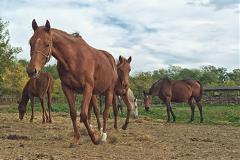Equine Gastric Ulcers: Symptoms, Diagnosis, and Treatment

Gastric ulcers are a common medical condition that can be found in horses of all ages. Also referred to as equine gastric ulcer syndrome (EGUS) or equine gastric ulcer disease (EGUD), it’s been estimated that gastric ulcers occur in nearly 50 percent of foals and 90 percent of weaned horses.
Four Factors that Cause Gastric Ulcers
1. Type of Feed
- High-grain concentrates tend to increase acid production
- Roughages require a lot of chewing, which stimulates saliva production and neutralizes stomach acid
2. Feeding Rates
Unlike in humans where the process of eating stimulates acid production, a horse’s stomach produces acid continuously. Horses that feed as a grazing animal eat small amounts frequently, but those that are stalled eat large amounts once or twice a day. When a horse has no food in its stomach, the acid accumulates and irritates the lining, which can create ulcers.
3. Stress and Exercise
Especially in high-performance animals such as race or show horses, the push for performance with increased training and exercise may cause mental and physical stress, which can contribute to creating ulcers. These horses also tend to be stabled without a companion, which also causes stress.
4. Non-Steroidal Anti-Inflammatory Drugs (NSAID)
Typically, horses on a treatment regimen of NSAID for more than ten days are at an increased risk for developing ulcers.
Two NSAIDs that block the chemicals that decrease acid production are:
- Phenylbutazone (Bute)
- Flunixin melamine (Banamine)
Symptoms
Stomach ulcers can involve multiple symptoms, including:
- Intermittent colic
- Poor appetite
- Restlessness
- Teeth grinding
- Excessive salivation
- Kicking at belly
- Biting at sides or belly
- Diarrhea
- Lying on the back
- Lying down more than normal
- Reluctance to train
- Weight loss and poor body condition
- Poor hair coat
- Depression
- Personality changes
Diagnosis
Typically, even with multiple symptoms, a diagnosis is not made until after completing:
- Medical history
- Clinical signs
- Physical examination
- Laboratory tests
- Gastroscopy
Treatment
In most, an improvement may be seen with a few days after the start of treatment. Clients need to be made aware that even if symptoms are no longer noticeable, ulcers take quite a while to heal. Depending on the severity, the recommendation for treatment may take several weeks, and a follow-up gastroscopy may be advised.
Treatment Part One:
- Remove any/all stressful conditions
- Discontinue any/all NSAIDs
Treatment Part Two:
Administer medications, which serve three purposes:
- Decrease acid production
- Buffer acid
- Protect the stomach lining
Treatment Part Three:
- Increase the number of feedings or put horse on pasture
- Increase the amount of diet roughage; alfalfa is high in calcium and felt to have qualities that aid ulcer care
- Decrease the amount of grain or remove grain altogether
- Add supplements to increase caloric content if grain is reduced or eliminated
- Give probiotics to aid digestion
Client Demonstration
The following demonstration may be useful when teaching clients about how the horse stomach works (Hahn, 2013).
- Using a clear Ziploc bag, draw a line two inches from the bottom of the bag. Explain that this represents the two types of stomach lining: the margo plicatus and the squamous mucosa.
- Pour liquid to the line and explain that when a horse is training, his stomach shrinks. Grab the bottom of the bag so the liquid rises above the line into the squamous mucosa.
- Add more liquid to the bag and explain that when horses are stressed they produce more stomach acid.
- Then to show how eating roughage helps the stomach, pour shavings into the bag and watch while the liquid is absorbed back below the line.
Hahn, J. (2013). Equine Ulcers. Integrative Veterinary Care. V214. Retrieved November 28, 2014 from http://www.ivcjournal.com/articles/equine-ulcers/


Working Here
Our team members are encouraged to be the best they can be... at Covetrus we believe we impact one another.
Learn MoreNews & Events
FDA Cautions Pet Owners Not to Feed Texas Tripe Inc. Raw Pet Food Due to Salmonella, Listeria Monocytogenes
The U.S. Food and Drug Administration is cautioning pet owners not to feed their pets any of the Texas Tripe brand raw frozen pet food listed below because several samples of Texas Tripe raw pet food have tested positive for Salmonella and/or L. mono.
Careers
Are you looking for a place to let your talents shine? At Covetrus, we help our practitioner customers better serve their patients and take pride in providing the best customer experience possible. Search our open positions to see our available opportunities.
Newsletter
Stay current with what’s going on with Covetrus, subscribe to receive our newsletter and email communications. Subscribers will receive the latest information in practice management, sales and marketing, animal health, and more.



-3-(1).png?sfvrsn=2d806d73_0)

Leave a comment